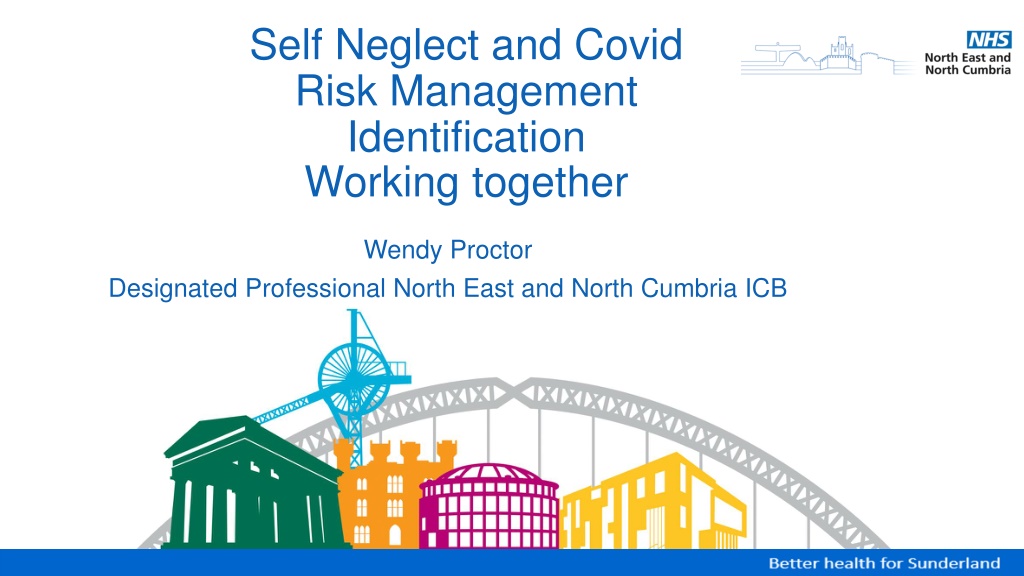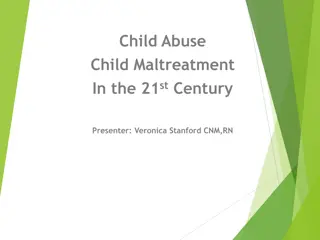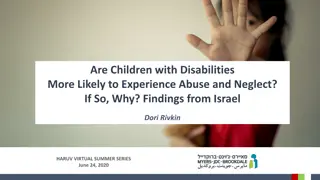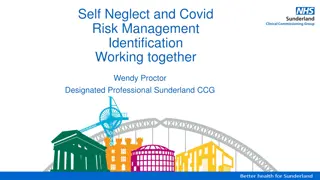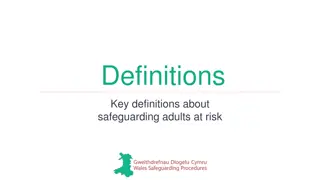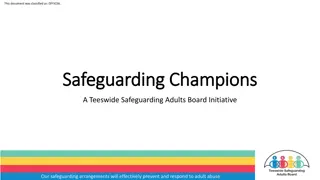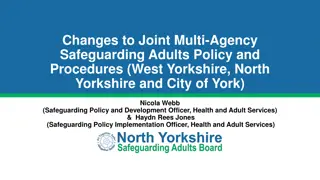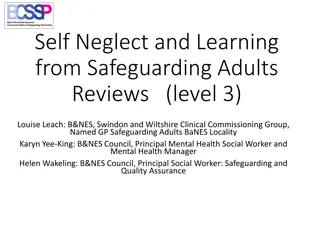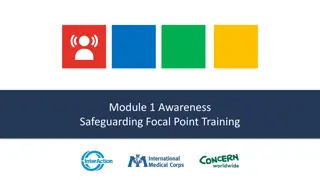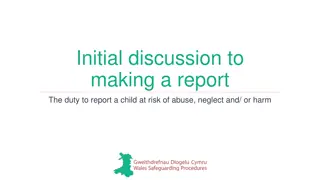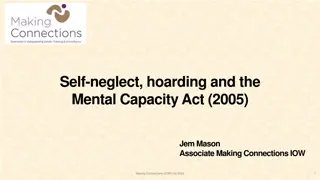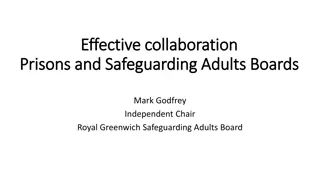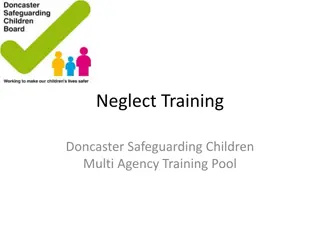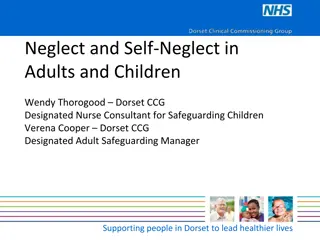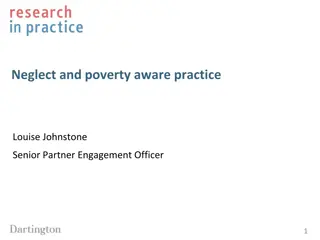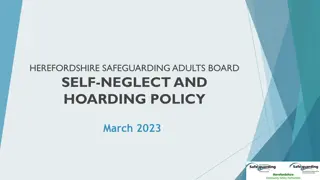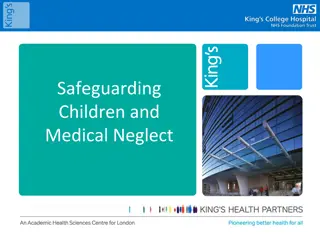Understanding Self-Neglect and Covid Risk Management in Safeguarding
Self-neglect is a complex issue that involves neglecting personal care and environment, posing health risks. Legislation and guidance, lack of standard definition, and factors contributing to self-neglect are explored, emphasizing the importance of a comprehensive understanding in safeguarding vulnerable individuals.
Download Presentation

Please find below an Image/Link to download the presentation.
The content on the website is provided AS IS for your information and personal use only. It may not be sold, licensed, or shared on other websites without obtaining consent from the author. Download presentation by click this link. If you encounter any issues during the download, it is possible that the publisher has removed the file from their server.
E N D
Presentation Transcript
Self Neglect and Covid Risk Management Identification Working together Wendy Proctor Designated Professional North East and North Cumbria ICB
Legislation and Guidance 2014 - Care Act brought self neglect into safeguarding 2016 Care Act revised guidance Self neglect may be section 42 or may lead to other pathways. To be considered ; Mental Health Act 1983 Mental Capacity Act 2005 Human Rights Act 1998 Making Safeguarding Personal Clinical risk management Housing / environmental issue Homeless support pathways Substance abuse service referrals
Definition of Self Neglect There is not an accepted definition of self-neglect but the Care Act Statutory Guidance 2016 defines self-neglect as: A wide range of behaviour neglecting to care for themselves and or their health or surroundings and includes behaviour such as hoarding . Gibbons et al 2006 defines as the inability (intentionally or unintentionally) to maintain a socially and culturally acceptable standard of self-care with the potential for serious consequences to the health and wellbeing of those who self-neglect and perhaps to their community . Self-neglect differs from other safeguarding concerns as there is no perpetrator of abuse, however, abuse from others can be a contributing factor of self-neglecting. Although self- neglect is predominantly seen amongst vulnerable, single individuals, it does also affect families, and therefore can have a much wider and detrimental impact on families including putting children at risk. Professionals are advised to Think Family in all cases of self-neglect.
Definition of Self Neglect Whilst there is currently no standard definition self-neglect, in addition to the Care Act (2014) definition above, three recognised forms of self-neglect include: Lack of self-care this may involve neglecting personal hygiene, nutrition and hydration or health e.g. non-attendance at medical appointments. Lack of care of one's environment this may result in unpleasant or dirty home conditions and an increased level of risk in the domestic environment such as health and safety and fire risks associated with hoarding. Refusal of services that could alleviate these issues, this may include the refusal of care services, treatment, assessments or intervention, which could potentially improve self-care or care of one's environment.
Complex Issues Self-neglect involves a complex interplay of physical, mental, social, personal and environmental factors. These all need to be explored to understand the meaning of self-neglect within the context of the adults life experiences. Contributory factors could include: Physical health issues: impaired physical functioning, pain, nutritional deficiency Mental health issues: Depression, impaired cognitive functioning, frontal lobe dysfunction Substance misuse: Alcohol, illicit substance use Psychosocial factors: isolation, unable to access community services, trauma, bereavements, other traumatic life events
Identification of Self Neglect Neglect of personal hygiene Malnutrition/dehydration poor diet and evidenced through lack of food in the cupboards/mouldy food Unmet medical needs, e.g. refusing to take insulin for diabetes. Refusing to take medications or attend health appointments Refusing to allow access to health or social care professionals in relation to personal hygiene and care Refusing to allow other professionals into the property including housing, utility companies Displaying eccentric behaviours Obsessive hoarding Repeated episodes of anti-social behaviour either by the person or as a target from others Lack of personal hygiene leading to poor healing/sores, long toe nails, uncared for hair/facial hair, body odour, unclean clothing Isolation/withdrawal from community networks Repeated referrals to environmental health/housing
Self neglect and Carers Neglect (Neglect) Self-neglect can also occur as a result of not being provided with the appropriate care by others, this could include a relative, friend, carer or other individual involved in a person s care. This may occur as a result of intentional neglect or neglect as a result of a lack of a knowledge, legal literacy and not applying policy and procedures. Examples of this can include not being provided with enough food or with the right kind of food, or not being cared for appropriately. Leaving someone without help to wash or change dirty or wet clothing, not getting a person to a doctor when needed or not making sure someone has the right medications, all count as neglect. A lack of care planning, assessment or obtaining a person s social history may also be examples of neglect. Failing to apply the Mental Capacity Act 2005 where someone is refusing care but is unable to retain, understand, weigh up or communicate the risks involved with refusing care is also an example.
Duty of Care Safeguarding adults at risk of self-neglect and hoarding can be challenging for professionals, the need to promote an adults choice and the duty of care to protect them from harm. Safeguarding people who self-neglect should be a shared multi-agency approach responsibility. Professionals should be aware of their duty of care even when an individual has been assessed as having the mental capacity. A duty of care is the obligation to exercise a level of care towards an individual, as is reasonable, in all circumstances, by taking into account the potential harm that may reasonably be caused to that individual or his property. This means to support an individual to achieve their outcomes whilst promoting their safety .
SCIE research 2014 Set out to identify what could be learnt from policies and practices that have produced positive outcomes in self-neglect .. Self-neglect practice was found to be more successful where practitioners: took time to build rapport and a relationship of trust, through persistence, patience and continuity of involvement tried to find the whole person and to understand the meaning of their self neglect in the context of their life history, rather than just the particular need that might fit into an organisation s specific role. worked at the individual s pace, but were able to spot moments of motivation that could facilitate change, even if the steps towards it were small ensured that they understood the nature of the individual s mental capacity in respect of self-care decisions were honest, open and transparent about risks and options had an in-depth understanding of legal mandates providing options for intervention made use of creative and flexible interventions, including family members and community resources where appropriate engaged in effective multi-agency working to ensure inter-disciplinary and specialist perspectives, and coordination of work towards shared goals.
SCIE research 2014 In turn, the organisational arrangements that best supported such work included: A clear location for strategic responsibility for self-neglect, often the Local Safeguarding Adults Board (LSAB) Shared understandings between agencies of how self-neglect might be defined and understood Data collection on self-neglect referrals, interventions and outcomes Clear referral routes Systems in place to ensure coordination and shared risk management between agencies Time allocations within workflow patterns that allow for longer-term supportive, relationship-based involvement Training and practice development around the ethical challenges, legal options and skills involved in working with adults who self-neglect Supervision systems that both challenge and support practitioners.
Mental Capacity and Self neglect When there are concerns regarding self-neglect, it needs to be clear about an adult s mental capacity in respect of any proposed intervention. Where there are concerns regarding an individual s mental capacity in relation to refusing care or choosing their living conditions, a mental capacity assessment must be undertaken. In extreme cases of self-neglect and extreme hoarding, professionals should question whether an individual has capacity to consent to the proposed intervention. The five key principles outlined in the Mental Capacity Act Codes of Practice must be followed when considering cases involving self-neglect and hoarding: Assumption of capacity All practicable steps to support the individual Unwise decisions Best Interests Least restrictive option The Mental Capacity Act 2005 is particularly relevant to cases of self-neglect and hoarding, one of the key principles is that an individual is not to be treated as unable to make a decision merely because he makes an unwise decision .
Mental Capacity and Self Neglect Assessment of capacity in relation to self-neglect or hoarding behaviour must be time and question specific, and relate to the specific intervention. The professional responsible for undertaking the capacity assessment, will be the professional who is proposing the specific intervention. When assessing an individual s mental capacity careful consideration should be given to the difference between the ability to make a decision (decisional capacity) and capacity to actually carry out the decision (executive capacity). An individual who self-neglects may have decisional capacity but may lack the ability to execute their decision. If an individual is deemed to lack capacity to make the proposed decision, then decisions must be made following the best interests process, including the individual s views and the least restrictive action. All mental capacity assessments should be recorded to support the intervention, in some cases that are challenging and complex, professionals should speak with the Safeguarding Team.
Case Study Consideration Male age 45 Recent release from prison MH admission Underlying untreated psychosis and substance abuse issues Lack of comprehensive capacity assessments Poor functioning / self neglect/ lack of ability to sort finances / cooking etc Supported accommodation and support for finances Not reported missing for 10 days Multiple A&E attendance whilst missing from accommodation Found deceased in derelict house death from hypothermia no evidence of excess substances in system had own room and money in the bank untouched when found
Covid and Self Neglect Isolation and fear Limited access to support Limited face to face contact /assessment Limited access to technology Increased poverty poor social conditions Housing issues Connected /coordinated working reduced in covid conditions Carer stress Limited respite or none for carers
Covid and Self Neglect National increase in self neglect referrals 2020-2022 Increased referrals for Safeguarding Adult reviews ( SAR) featuring self neglect 2020-2022 Significant increase in 2022, 30 % increase in safeguarding referrals for 18 64 year olds Cases involving self neglect, substance abuse , homelessness and complex health concerns Majority of these cases either went to a Section 42 or remained within the safeguarding process Increased rate of complex cases Section 42 featuring self neglect
Factors Contributing to Poor Outcomes Value judgments around "lifestyle choice." Poor multiagency working and lack of appropriate information sharing. Lack of clarity on leadership and case management. Assumptions that support is being provided. Lack of engagement and challenges from the individual or family; creating barriers to engagement. Assumptions about caring roles within families including their capability to fulfill this role. A de-sensitisation to well known cases, resulting in minimisation of need and risk. Poor risk assessment or no risk assessment Plans and engagement for outcomes being solely based upon mental capacity. Chaotic lifestyles and multiple or competing needs. Inconsistency in application of thresholds across agencies and teams.
Learning from Safeguarding Adult Reviews Regarding Self Neglect Early information sharing, in relation to previous or on-going concerns. Thorough and robust risk assessment and planning. Face-to-face reviews. A clear interface with safeguarding adults procedures. Effective collaboration between agencies. Increased understanding of the legislative options available to intervene to support or safeguard a person who is self-neglecting. Application and understanding of the Mental Capacity Act (2005).
Learning from Reviews Where an individual refuses services, ensure the individual is fully informed on options and risks and ensure mental capacity is considered. Clear and detailed documentation, including a decision-making rationale. Re-visiting services and support at regular intervals: it may take time for an individual to be ready to accept some support. Management support for an approach which reflects the individuals' pace and ongoing review/case management Practitioners and managers challenging and reflecting upon cases through the supervision process and training. Robust guidance to assist practitioners in working in this complex area. Assessment processes which identify if carers and significant others are utilising a whole family approach
CARM Complex Adult Risk Management Risk Management. The CARM process provides a framework for professionals to facilitate effective multi-agency working with vulnerable adults/adults at risk (adults with care and support needs, whether these are being met or not) 18 or over who are deemed to have mental capacity and who are at risk of serious harm or death through self- neglect, refusal of services and/or high levels of risk taking activity. This process and guidance should be used for discussing, identifying, assessing, recording, planning and reviewing the management of this risk, wherever possible in partnership with the adult at risk and with their consent. This process applies in residential care and in the community settings and should be considered for use in health settings.
CARM criteria The following criteria should be followed when considering a CARM: A person must have capacity to make decisions and choices regarding their life There is a risk of serious harm or death by severe self-neglect, fire, deteriorating health condition, non-engagement with services or where an adult is targeted by local community, is the victim of Hate Crime or Anti-Social Behaviour or the victim of sexual violence, complex drugs and alcohol use, complex homelessness and where they have declined to engage with a single agency or other investigations for Safeguarding There is a public safety interest (not always applicable) There are a high level of concerns from partner agencies (When applicable) Hoarding clutter index and or above 6/Fire Risk
Key Principles Information Sharing Inter-agency agreements already exist to protect individuals against experiencing serious harm and Caldicott Principals exist to protect agencies sharing information on a need to know basis in order to prevent harm. Each agency needs to be aware of the principals of sharing information and be aware of the threshold of sharing information on a need to know basis . Human Rights Considerations It is an essential part of the process that people are involved as far as possible, and have a right to privacy and to make unwise decisions if they have capacity to do so. However the Human Rights Act gives primacy to the Right to Life (HRA 1998 article 2). However a decision may sometimes be overridden due to public safety concerns. The CARM meeting is an opportunity to ensure that all agencies have offered support and options to individuals whose life is at serious risk or harm. Quality Assurance Each agency is required to maintain records of the CARM and assure the quality of referrals. The Local Authority Safeguarding Adults Team will collect and produce data about the CARM process. Quality will be assured through audits completed as part of the Quality and Assurance sub-group of the Sunderland Safeguarding Adults Board.
Complex case management Multi agency working
Reference to supporting documents Care Act Statutory Guidance DOH 2016 Care Act 2014 Mental Capacity Act 2005 Human Rights Act 1998 Mental Health Act 1983 Making Safeguarding Personal https://humbersidefire.gov.uk/your-safety/safety-in-the-home/hoarding www.helpforhoarders.co.uk Self-Neglect and Practice: building an evidence base for practice SCIE 2014 Sunderland Safeguarding Adult Board (SSAB) Complex Adult Risk Management protocol (CARM) SSAB Self Neglect Practice Guidance SSAB Professional Curiosity Guidance document http://www.sunderlandsab.org.uk/ Suffolk Safeguarding Adults Board Self Neglect and Hoarding Gloucestershire Safeguarding Adults Board Adult Self-Neglect Best Practice Guidance Research in Practice for Adults, Practice Tool Working with people who self-neglect.
